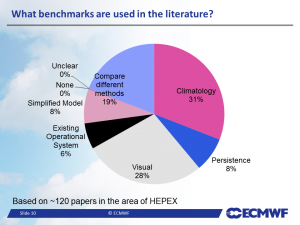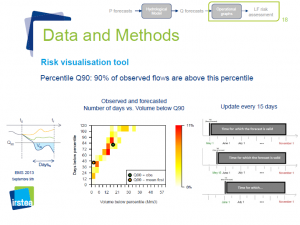EMS2013- A bright diversity
Contributed by Giuseppe Ricciardi and Massimiliano Zappa
 Here below a short report from the 13th EMS Annual Meeting & 11th European Conference on Applications of Meteorology (ECAM), on “High Impact Weather: Working in Partnership to Reduce Risk” held on 09–13 September 2013 in Reading, UK.
Here below a short report from the 13th EMS Annual Meeting & 11th European Conference on Applications of Meteorology (ECAM), on “High Impact Weather: Working in Partnership to Reduce Risk” held on 09–13 September 2013 in Reading, UK.
Which presentation did you like most at the EMS???
Just in the first day of the conference some hydrology was proposed to the audience, mostly composed by meteorologists and climate scientists. The session ASI19 on Monday, 9 September, dealing with “Interfacing hydrological and meteorological models in forecasting systems”, addressed developments in the coupling between meteorological and hydrological models, letting ensemble systems to emerge. This session also addressed the contributors of HEPEX (Hydrological Ensemble Prediction Experiment) and HyMeX (Hydrological cycle in the Mediterranean Experiment). During the 120 minutes of the session, an average of 70 participants got some news from the hydrology community. Here below we detail on the seven presentations and the three posters.
J. P. Schulz presented the verification of the ground heat flux computed by the land surface scheme TERRA of the COSMO atmospheric model, showing that the overestimation of the ground heat flux during daytime leads to an underestimation of the other surface fluxes and a reduced surface warming. During afternoon and night, this behaviour is reversed.
A. Lombardi showed the main characters of the Cetemps Hydrological Model (CHyM) and the weather forecast models WRF- ARW; secondly the features of the CETEMPS Hydro-Meteorological chain. Finally, she showed the nowcasting (6-12 hour) application in Central Italy, during HyMex campain (5 October-6 November 2012) using two flood alarm indices.
Slide from Pappenberger et al.
F. Pappenberger gave definitions on no skill, fake skill and real skill in probabilistic hydrological flood forecasting. He showed also the evaluation of a large variety of different options of benchmark and evaluated their individual skill. He demonstrates the methodology on the example of the European Flood Awareness System, running in operational mode at the European Centre for Medium Range Weather forecasts (ECMWF) in collaboration with other European partners. This is part of the verification testbed project of HEPEX.
Presentation by Ricciardi et al.
G. Ricciardi showed the use of the COSMO LEPS ensemble in a Flood Warning Regional Centre in Italy and the perspectives it has through collecting other case studies, also on small catchment, and implementing performance indicators.
F. Wetterhall compared results of different hydrologic modeling, taking in account their performance at the observational stations. He showed that using more than one hydrological model increases the robustness of a system as the model uncertainty as well as individual model performance can be used to improve flood forecasting systems.

S. Jörg-Hess presented the use of the ECMWF VarEPS 5-member ensemble reforecast to test the forecast skills of hydrometeorological models with respect to streamflow drought. Reforecast allowed generating time series of daily runoff forecasts (lead-times up to 32 days). They were verified on low stream flows, and the derived duration, severity and magnitude.
Slide from Crochemore et al.
L. Crochemore showed an application on water reservoirs with multiple uses. The forecasting system is based on the GR6J hydrological model. Medium-range meteorological forecasts from the ECMWF ensemble prediction system (51 scenarios up to 9 days ahead) are associated with historical data to provide streamflow scenarios for the summer period. These scenarios are summarized in a graphical way so as to provide decision makers with the probabilistic forecasts and the associated risks of low flows. Preliminary results were presented and the capacity of the system to provide useful information in an operational context was discussed. The study is part of the Interreg DROP project.
In the poster session:
• M. Cousteau presented the last improvements leading to the new operational hydro-meteorological ensemble prediction system at Meteo-France and French service for flood prediction (SCHAPI). The operational hydro-meteorological model SAFRAN-ISBA-MODCOU (SIM) has been used since 2005 for producing ensemble streamflow forecasts based on ECMWF EPS. The presented new version of the forecasting chain has improvements in atmospheric products, physics of the ISBA model and past discharges assimilation. Experiments were performed to separately assess these improvements. Finally, Meteo France and SCHAPI have developed a new website showing streamflow predictions, as well as alerts for high flows.
• P. So Yeon showed that in Korea droughts can occur during spring. Analysis has been undertaken at the National Institute of Meteorological Research, Republic of Korea, on the distribution and synoptic characteristics of selected cases of spring precipitation (even distribution of rainfall throughout the country for the recent five years). The aim was to assess the value of spring precipitation in the aspect of securing spring water resource. Moreover, the value of spring precipitation has been estimated in terms of water resource after estimating the runoff discharge of the selected days based on the representative watershed-based dam.
• K. Schneider discussed about coupled meteo-hydrological modeling. She gave examples on flood forecast from alpine watersheds with varying predictive quality, focusing on quality of meteorological now- and forecast (precipitation intensity, amount and duration), catchment state and performance of the hydrological model. Local key elements are snow melt in spring, runoff generation by glacier in summer, and the dynamics of the snow cover that may either bring to dampening or magnification of the flood peaks. These are the challenges to be managed by the Flood forecasting system for the river Inn (HoPI) in Tyrol (Austria).
It has been a well-received session and an important message to maintain a fruitful dialog between hydrologists and meteorologists.



September 25, 2013 at 20:37
Unfortunately I was only able to come for 2 days to the EMS (Monday and Friday) and I really enjoyed the session above. On Friday I really liked the talks in NWP 4 Probabilistic and ensemble forecasting at short and and medium-range (http://meetingorganizer.copernicus.org/EMS2013/oral/13153) – in particular the presentation by Williams et al (http://meetingorganizer.copernicus.org/EMS2013/EMS2013-183.pdf) who compared pre-processing routines with a special focus on extreme events.